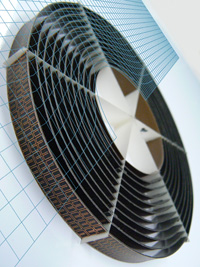Transformation Optics
 The design of optical components is often based on the use of simple materials that can manipulate light through the phenomenon of refraction. When a ray of
light impinges on the interface to a material (glass or plastic, for example), its trajectory is modified, bending as it enters the material by an amount related
to its index-of-refraction. Snell's law provides the quantitative relationship between the angle of deflection and the index-of-refraction, and serves as the primary
design tool for the lenses used in eyeglasses, microscopes, cameras, telescopes, and many other devices.
The design of optical components is often based on the use of simple materials that can manipulate light through the phenomenon of refraction. When a ray of
light impinges on the interface to a material (glass or plastic, for example), its trajectory is modified, bending as it enters the material by an amount related
to its index-of-refraction. Snell's law provides the quantitative relationship between the angle of deflection and the index-of-refraction, and serves as the primary
design tool for the lenses used in eyeglasses, microscopes, cameras, telescopes, and many other devices.
As the material complexity increases, simple ray tracing no longer becomes a viable approach for optical device design. Metamaterials offer particular challenges in this regard because they provide unprecedented flexibility in terms of material properties. Metamaterials can easily support both electric and magnetic response, which can vary both as a function of direction as well as spatial location within the material. This extraordinary freedom makes possible a nearly unlimited set of device solutions; identifying the useful solutions, however, can be a difficult undertaking.
Transformation optics is a new optical design methodology that was developed in 2006 to harness the true potential of metamaterials. The basic question arises: Given all the opportunities that metamaterials offer, is it possible to create new optical devices that couldn't have easily been designed using conventional design techniques? The answer to this question is a definitive 'yes,' and transformation optics provides the path. One particularly exciting example is that of the 'invisibility cloak,' which has now served as one of the grand challenges of transformation optics and metamaterials. The solution for an invisibility cloak falls out immediately and naturally from the transformation optics formalism. Though the required material for a transformation optical cloak is indeed complex and difficult to achieve, artificially structured metamaterials provide the tools for implementation. Various versions of invisibility cloaks have now been demonstrated that operate over bands of wavelengths in the microwave spectrum, through the visible.
The transformation optical design approach makes use of coordinate transformations to arrive simultaneously at the desired optical functionality of a device and its material distribution. Based on the invariance of Maxwell's equations, transformation optics allows light in one coordinate system to behave as if propagating in a different coordinate system. How does this work? Imagine a grid representing the standard Cartesian coordinate system, drawn on a sheet of rubber. Light travels in a straight line in free space, so that one can imagine any of the grid lines representing the path that light would take (think of a laser beam shining parallel to one of the grid lines). Now, stretch, skew or otherwise warp the sheet of rubber. The grid lines will also stretch, and serve as a pictorial representation of the coordinate transformation.
If space could be stretched and warped just like the sheet of rubber, then light would now follow the curving, twisting path of the grid lines. It would be an interesting way to create an optical device, but completely impractical since only truly massive objects can produce any appreciable distortion of space. However, using the invariance of Maxwell's equations, it is, in fact, possible to create a material that will cause light to behave exactly as the coordinate transformation predicts. This material specification defines a transformation optical medium.
Woring with Sir John Pendry, our group helped to develop the underlying concepts of transformation optics in 2006, and later that year demonstrated the first transformation optical metamaterial: The 'invisibility cloak' that operated over a small band of microwave frequencies. While definitely not a challenge to Harry Potter's invisibility cloak, nevertheless the Duke microwave invisibility cloak established the viability of transformation optical design, and fired the imaginations of many researchers. Over the years, our group has continued to develop transformation optical cloaks and many other transformation optical devices, exploring the fundamental concepts as well as potential applications.
More Information...

In collaboration with Sir John Pendry, our group proposed the use of Transformation Optics for the design of an invisibility cloak.

A transformation optical design was used to create a metamaterial cloak, consisting of concentric layers of metamaterial resonators.

The first metamaterial cloaks confirmed the transformation optical design approach.